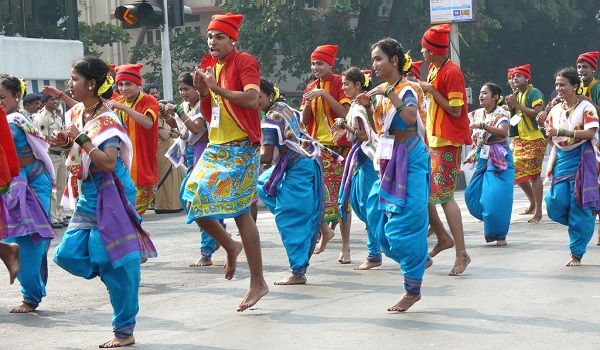Known for its rich culture and heritage, West India is home to a variety of several folk dance forms. Both men and women folks hog the limelight when it comes to participating in cultural events. These folk dances are an integral part of almost all festivals and celebrations. Let’s have a look at some of the most interesting and popular folk dances of West India.
Dandiya
Region/Area: Rajasthan/ Gujarat
Occasion: Performed during Navratri festival
Highlight: Performers wield sticks and dance skillfully
Dandiya is a popular folk dance of Rajasthan and Gujarat. Dressed in colorful costumes, the performers wield sticks and dance skillfully by striking the sticks held by their fellow dancers. Dandiya dance is accompanied by a musical instrument called 'Meddale'. This percussion is played by the drummer who is always placed at the center. Other percussion instruments such as ‘Dholak’ and ‘Tabla’ are also used.

Garba
Region/Area: Gujarat
Occasion: Performed during Navratri festival
Highlight: Women perform with earthen pots which in turn hold lighted lamps
Garba is the leading dance of women in Gujarat. The dance is associated with the fertility cult. It is performed on nine consecutive nights of Navaratri, an autumn festival. Women folk come out in the open, carrying perforated earthen pots on their head, which in turn hold lighted lamps. They sing, clap and perform a simple dance by forming a circle in order to praise Goddess Amba. When men too, join in by singing, clapping and dancing, the dance is then called ‘Garbi’.

Image source: http://www.dnaindia.com
Tippani Dance
Region/Area: Saurashtra
Occasion: Festivals and weddings
Highlight: Women hit the floor with wooden rod which sometimes has an iron tip
Tippani is one of the most famous dances of Saurashtra. Performed by women on occasions like festivals and weddings, the dance involves performers hitting the floor with wooden rod which sometimes has an iron tip. The performance is well supported by instruments such as ‘Manjira’, ‘Tabla’, ‘Zanz’, ‘Dhol’ and ‘Shehnai’.
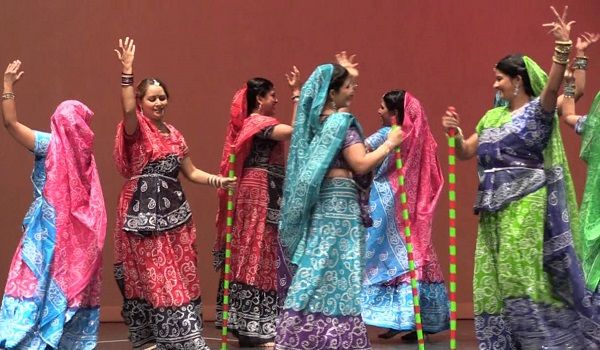
Image source: YouTube.com
Padhar Dance
Region/Area: Gujarat
Occasion: Performed in rituals and for entertainment purpose
Highlight: The dance involves illustration of waves
Since the Padhar community is wanderlust in nature, their folk dance is basically an illustration of their livelihood, which largely depends on fishing. Hence, their dance depicts the lives of mariners and the wavy nature of sea. Also, since the community is a happy-go-lucky lot, their dance involves fun elements as well.

Siddi Dhamal
Region/Area: Gujarat
Occasion: Performed after successful hunting of animals
Highlight: The dancers throw coconuts up in the air and break them open using their head
Performed by the Siddi community of Gujarat, this unique folk dance was originally performed after the successful hunting of animals. Nowadays, the dance is performed on special occasions as part of their celebration. Interestingly, dancers throw coconuts up in the air and break them open using their head. Another interesting fact about this dance is that the performers also dance on red-hot embers to the beats of the drums played.
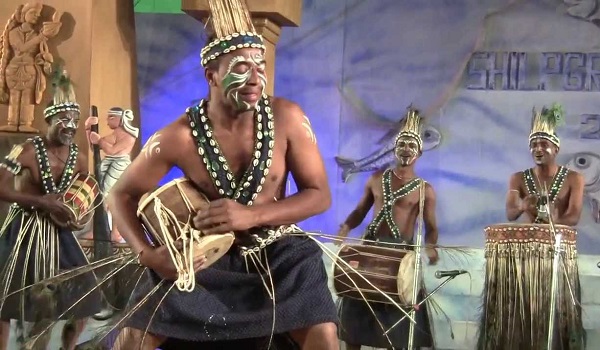
Bhavai Dance
Region/Area: Rajasthan
Occasion: Performed in rituals and festivals
Highlight: Dancers balance multiple pots or pitchers on their head while standing on top of glass bottles or on the rim of a brass plate
Usually performed by women dancers, Bhavai dance requires its performers to balance multiple earthen pots or brass pitchers on their head. The balancing act is done while standing on top of glass bottles, on the rim of a brass plate or even on the edge of a sword. The dancers sway to the beats of the music. The performance is supported by men who sing melodious folk songs and play different instruments like ‘Dholak’, ‘Jhanjhar’, ‘Sarangi’ and Pump organs.
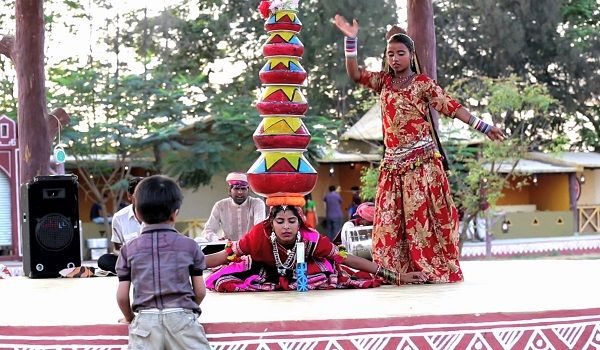
Tera Tali
Region/Area: Rajasthan
Occasion: It is a devotional dance performed during festivals
Highlight: The dancers also hold a sword using only their teeth and balance a pot on their head
Tera Tali is one of the most popular folk dances of Rajasthan. It is performed by a small group of women, belonging to the Kamar tribe. The women folk begin their performance by squatting which is a ritualistic move. What’s most interesting about this dance is that metal cymbals (Manjiras) are tied to different parts of the performer’s body, mostly to the legs. The Tera Tali dancers hold cymbals in their hands and strike them in a rhythmic manner. The dancers also hold a sword using only their teeth and balance a pot on their head.Singing and playing of instruments are done by the men folk.
Ghoomar
Region/Area: Rajasthan
Occasion: Performed in weddings and during festivals
Highlight: Women wear colorful costumes, making the dance eye-catching
Performed only by women during special occasions like weddings and festivals, Ghoomar is one of the most common folk dances of Rajasthan. The dance requires women to perform a pirouette while moving in a circular motion. The dancers wear colorful costumes, making the dance eye-catching.
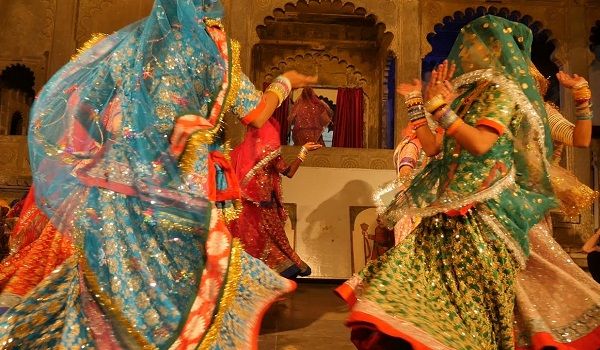
Image source: YouTube.com
Kalbeliya Dance
Region/Area: Rajasthan
Occasion: Performed as part of almost all celebrations
Highlight: Dancers emulate the movements of snakes
Performed by the community of snake charmers, Kalbeliya dance involves dancers emulating the movements of snakes. Usually performed by young women who wear black colored outfits, the dance also includes acrobatic moves. Musical instruments like ‘Pungi’, ‘Dufli’, ‘Khanjari’, ‘Dholak’, ‘Khuralio’ and ‘Morchang’ are played by the men.
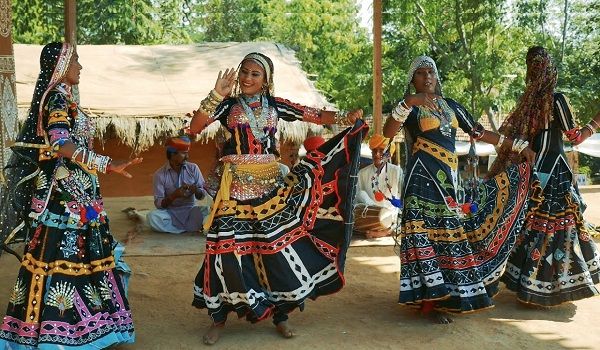
Kachchhi Ghodi dance
Region/Area: Rajasthan
Occasion: Performed in weddings to entertain the bridegroom’s party
Highlight: Dance takes the form of a horse ride
Performed in weddings to entertain the bridegroom’s party, the Kachchhi Ghodi dance has its similarities with the Ghodemodni dance of Goa. Like Ghodemodni, the performers of KachchhiGhodi too, are required to mount a fake horse and are often seen wielding swords. The dancers sway to the tunes of flutes and the beats of percussions like ‘Dhols’. The act also includes singers, who support the performance with their folk songs.
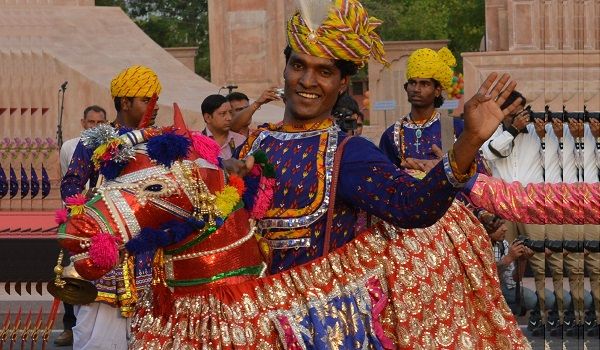
Image source: Pinterest
Chari Dance
Region/Area: Rajasthan
Occasion: Performed in weddings and during occasions like festivals and birth of a male child
Highlight: Women dancers carry earthen or brass pots which are set on fire
Performed in weddings and during occasions like festivals and birth of a male child, Chari dance involves women performers. The dancers balance earthen or brass pots on their head and to make things that much more interesting, the pots are set on fire. Dancing involves gentle movements of their lower body. Musical instruments used to support the performance include ‘Dholak’, ‘Dhol Harmonium’, ‘Nagada’ and ‘Thali’.
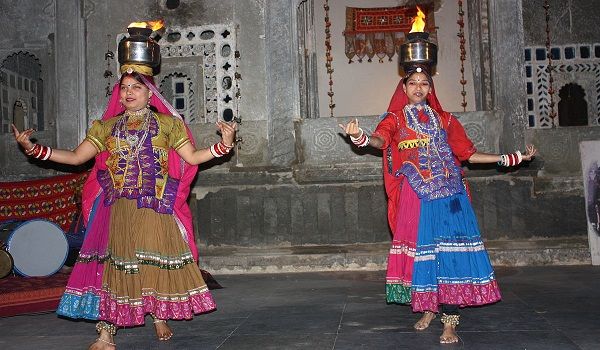
Pavri Nach
Region/Area: Maharashtra
Occasion: Performed during festivals
Highlight: The performers use a typical instrument called ‘Tarpha’ which makes a unique sound
Performed by the Kokna tribe of Maharashtra, Pavri Nach involves both men and women. The performers form a circle by placing their arms on the waist of the adjacent dancer and go about dancing with the support of a musical instrument known as ‘Tarpha’. ‘Tarpha’ is a wind instrument made up of dried gourd and produces a typical sound when used.
Dindi and Kala Dance
Region/Area: Maharashtra
Occasion: Performed on the Ekadashi day in the Hindu month of Kartik
Highlight: Mischievous acts of Lord Krishna are enacted
Dindi and Kala are devotional folk dances of Maharashtra. In these dances, the playful attitude of Lord Krishna is presented. Dindi is a small drum. The musicians, comprising 'Mridangam' player and a vocalist, stand in the center and give the dancers the necessary musical background. Men and women folk perform the dance based on the rhythmic music. This dance is usually performed on the Ekadashi day in the Hindu month of Kartik.
Povadas
Region/Area: Maharashtra
Occasion: Performed in festivals and rituals
Highlight: ‘Shahir’, the lead performer is a major attraction
Originally formulated to portray the bravery of the Maratha king Chhatrapati Shivaji, Povadas has undergone many changes since then. Today, the dance performance is used to highlight historical, political and social events. ‘Shahir’, the lead performer does the singing and dancing while a group of men referred to as ‘Jhilkari’ offer him the required support. They play musical instruments such as Drums, Cymbals, Tambourine and ‘Tuntune’.
Koli
Region/Area: Maharashtra
Occasion: Performed in festivals
Highlight: The fisherwomen express their interest towards thefishermen during the performance
Koli dance derives its name from the Koli tribe of Maharashtra. The dances of the Kolis incorporate all elements of their surroundings. The Koli dance is performed by both women and men - divided into two groups, who subsequently form two rows. The main story of the dance is enacted by the smaller group of men and women. In this dance, the Kolin or fisherwomen express their interest towards the Kolis or fishermen. The dancers usually carry oars while dishing out their performance.
